Content
- Understanding the links between skill, ability, learning and performance
- Learning curves
- Observational learning
- Stages of learning
- Transfer of learning
The learning of a new skill and the development of an existing skills requires the coach and the athlete to understand what we can develop and how best this is achieved. To improve performance skills need to be identified and specific approaches taken.
The link between skill and ability is that the more ability an individual has the easier it will be to learn skills that utilise that ability i.e. skill is the application of ability, and skills are learned using existing abilities.
SKILL is ‘the learned ability to bring about pre-determined results with maximum certainty, often with the minimum outlay of time or energy or both.’ Barbara Knapp (1977)
ABILITY – describes the physical attributes that affect our potential for a given sport. Abilities are largely determined genetically i.e. they are natural or innate. ‘Motor abilities are relatively enduring traits which are generally stable qualities that help a person carry out a particular act.’ (Fleishman)
| MOTOR ABILITY | SKILLS DEPENDENT ON ABILITY |
| Co-ordination | Kicking a ball, cartwheel. |
| Reaction Time | Tennis serve return, interception in netball. |
| Balance | Handstand, landing a jump. |
LEARNING – is ‘the more or less permanent change in behaviour that is reflected in a change in performance’ (Knapp). Learning is a lifelong process – even elite sports performers claim that they are still learning about their sport in order to improve their performance. Every learner will progress through the stages of learning, given appropriate opportunities to practice and receive feedback.
PERFORMANCE – is a demonstration of the solving of a problem or task at a given moment in time i.e. it is a temporary phenomenon. We can all think of very skilful performers that have an abundance of ability who sometimes turn in a poor performance.
LINK BETWEEN LEARNING AND PERFORMANCE – as learning takes place we usually see gradual improvement in performance.
LEARNING/PERFORMANCE CURVES – the rate of learning can be measured in a variety of ways: Objective assessments e.g. testing
These improvements can be plotted to produce a learning curve, so that over a period of time it is possible to see how a performer is improving. There are a variety of shapes to learning curves, each giving us information relating to the rate of learning.
The rate of improvement is directly proportional to the number of practice sessions – there is constant improvement.
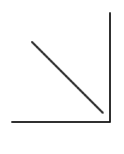
This shape shows that the individual has performed better in earlier sessions than in later ones – the rate of performance improvement is slowing. What could be the reasons for this? This could be explained by the performer having reached their potential, be receiving poor coaching, boredom etc.
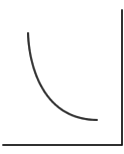
This shape shows that the individual has performed better in the later sessions than in the earlier ones, and that the rate of performance is getting faster.
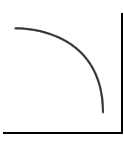
This often occurs when the athlete is trying to do too much and is over-tired, they could be lacking motivation, have reached their potential etc.
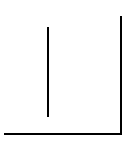
Make sure that you can give practical examples of abilities that link with skills – see table above. Remember that skill, ability, learning and performance link with stages of learning, feedback, types of practice etc.
As well as being able to interpret performance curves, you also need to be able to suggest strategies to maintain performance development.
1. (a) Figure 1 is a performance curve for a sportsperson learning a new skill.
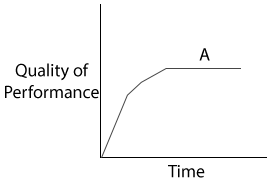
(i) Using Figure 1 to help you, identify what is happening to the sportsperson’s performance at A, and explain possible reasons for this occurrence. [3] (ii) Describe different strategies a coach or teacher may use to help a performer overcome what is occurring at A. [3]
OBSERVATIONAL LEARNING AND DEMONSTRATION – Social learning theorists believe that we learn by observing other people. This is known as observational learning. The person who is being observed is known as the ‘model’ and the process is called modelling. Teachers and coaches who use this theory use demonstration as the main learning tool. Demonstration is the application of modelling. One problem of observational learning is that coaches and teachers cannot always control what is being observed – boys often pick up bad habits through modelling their behaviour on professional sportsmen e.g. questioning referees’ decisions because they see it on TV. Bandura (1977) suggests that there are four processes in observational learning:
| ATTENTION PROCESSES | To be able to imitate a demonstration, the learner must pay attention to the demonstration using selective attention to pick out the relevant cues. A teacher/coach should highlight the relevant cues. |
| RETENTION PROCESSES | The observer must remember the model’s performance. They therefore need to create a mental picture. Retention can therefore be improved through repeated demonstrations and mental rehearsal. |
| MOTOR REPRODUCTION | This refers to the attempt by the learner at the modelled skill i.e. copying the performance. Demonstrations should be matched to the capabilities of the learner. The learner’s performance can be improved by practice and through the use of both intrinsic and extrinsic feedback. |
| MOTIVATIONAL PROCESSES | Learners tend to imitate what they are interested in, so this relates to why a learner would copy the model’s performance. The status of the model can affect motivation (this is why top footballers’ behaviour is imitated so much!). External reinforcement of the model will increase the motivation to imitate it. |
STAGES OF LEARNING – Fitts and Posner (1967) describe 3 phases of learning:
This refers to the effect that learning one task has on the learning of another. It is important to note that not all transfer enhances learning. Transfer is a complex concept and can take many forms:
POSITIVE TRANSFER – this occurs when prior learning promotes present learning e.g. there might be positive transfer from throwing a ball to executing the overhead clear in badminton.
NEGATIVE TRANSFER – this occurs when prior learning has an inhibiting effect on the learning of a new task e.g. there could be negative transfer for an experienced basketball player beginning to play netball as the different weight of the ball could cause the player to overshoot/overthrow.
ZERO TRANSFER – in this case prior learning has no effect on present learning e.g. skills learned in football would have no impact when learning to swim.
BI-LATERAL TRANSFER – this is transfer between limbs.
PROACTIVE TRANSFER – the effect that learning a skill has on a skill that has not yet been learned – this could be positive, negative or zero.
RETROACTIVE TRANSFER – the effect that learning a skill has on a previously learned skill, again the effect could be positive, negative or zero.
Stages of learning are very closely linked to information processing – processing becomes very much more efficient as you move through the learning phases.
1. Using examples, explain how transfer of learning has affected your sporting performance. (3)